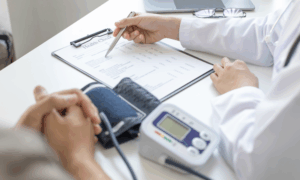| STT | LIST | DETAILED CONTENT |
|---|---|---|
| 1 | Doctor's examination | Review medical history, current medical condition, health concerns to personalize tests and imaging according to each person's specific problems. |
| 2 | Vital signs | Weight, height, pulse, blood pressure, BMI, vision. |
|
3
|
Blood test:
– Blood formula – Blood fat Blood sugar Liver enzymes – Kidney function – Screening for hepatitis B and C – Gout index – Thyroid function test |
Blood Formula: 1) Provide information about the three main types of blood cells: – Red blood cells: Measuring the number of red blood cells in the blood helps detect anemia. Regarding anemia, the following indicators also help to better assess the level of anemia and the cause of anemia: Hemoglobin (Hb): Measures the amount of hemoglobin in the blood, Hematocrit (Hct): Measures the percentage of red blood cells in the blood, MCV, MCH, MCHC: evaluates the average volume of red blood cells, average amount of hemoglobin, average hemoglobin concentration. – White blood cells: Measures white blood cell count, which helps detect infections, immune diseases, or hematological disorders. – Platelets: Measuring the number of platelets helps to partially assess the blood clotting status and detect platelet-related disorders. 2) Thanks to detailed information on blood cell components, doctors can diagnose early diseases of the hematopoietic system such as anemia, leukemia, thrombocytosis or provide early warning of other inflammatory diseases. |
| Blood Fat: 1) The blood lipid test kit includes 4 basic parameters with different health meanings: Total cholesterol, triglyceride, HDL-cholesterol, LDL-cholesterol. Things to remember: – HDL cholesterol: Not all types of cholesterol are dangerous. For example, HDL-cholesterol, which is a beneficial blood fat, “GOOD” fat, helps you prevent cardiovascular disease. Some foods that promote the production of HDL-cholesterol include: oats, fish, nuts – LDL cholesterol: is a “BAD” fat, increasing the risk of atherosclerosis, cardiovascular disease and stroke. Some foods that increase LDL-cholesterol: cheese, fried foods, foods with a high glycemic index, animal fat, red meat, etc. – Triglycerides: This is a type of body fat that is associated with heart disease and diabetes. Triglycerides levels can increase due to factors such as obesity, smoking, alcohol use, a diet rich in carbohydrates, lack of exercise, etc. 2) Understanding the basic information of blood lipid levels helps you have knowledge in screening for cardiovascular risk. It should be known that currently, about 150,000 people die from heart disease, which is both a symptom and the most serious complication. About 41% of deaths are due to myocardial infarction. |
||
| Blood Sugar: 1) Understanding the meaning of blood sugar index helps you understand how to screen for Diabetes.2) Diabetes can be detected early by examining the following blood test indicators: – Blood sugar at any given time – Fasting blood sugar (fasting for 6-8 hours) – Measure average blood sugar level over 3 months (HbA1C) – Glucose tolerance test (drink sugar water and do blood test) 3) Once you have your blood sugar information, you can learn how to adjust your diet and lifestyle habits in addition to medication (if any), to help prevent the disease as well as minimize complications of diabetes. |
||
| Liver Enzymes 1) ALT, AST, GGT là 3 chỉ số thường được bác sĩ chỉ định để đánh giá ban đầu về tình trạng của gan. – ALT and AST: Measure the levels of these enzymes to assess liver inflammation or damage. – GGT: in addition to causes such as diseases that damage the liver and biliary system, GGT is also related to lifestyle factors, diet, etc., for example: drinking beer, alcohol, using drugs, diet, fatty liver, etc. |
||
| Kidney Function: 1) The most commonly used index to assess initial kidney function is Creatinine. 2) From this index, doctors can estimate the glomerular filtration rate (roughly speaking, it measures the ability to filter out toxins and waste from the body). 3) If necessary, the doctor may prescribe more in-depth tests such as 24-hour urine protein, total protein, ionogram, abdominal ultrasound, etc. |
||
| Screening for Hepatitis B, C: 1) Blood tests help screen for infection with the most common hepatitis viruses: hepatitis B and C. These viruses can lead to chronic hepatitis, cirrhosis, and even liver cancer. 2) Based on the results of these tests, the doctor will continue to advise on vaccination (for hepatitis B), provide instructions on infection prevention measures, and prescribe treatment. |
||
| Gout Index: 1) Uric acid is often increased in people with a diet high in animal protein, who often drink alcohol and are sedentary. 2) Blood tests help determine the level of increased uric acid, suggesting a risk of gout, and a less noticed problem is kidney failure due to gout. 3) With a specific blood uric acid index, the doctor will advise on non-drug treatment, or medication if indicated, and explain to you the potential risks of gout to your health. |
||
| Thyroid Function Test: 1) Thyroid function assessment – The TSH index alone can indicate the health status of the thyroid gland. Depending on your symptoms, your doctor may prescribe additional tests such as: FT3, FT4, Tg, TPO, TgAb… 2) Hypothyroidism is a disease in which the thyroid gland produces too little thyroid hormone, resulting in a sluggish metabolism. Typical symptoms of hypothyroidism: weight gain, fatigue, feeling cold all the time, constipation, feeling of lack of energy,… 3) In contrast to hypothyroidism, hyperthyroidism is caused by overactivity of thyroid hormones, resulting in a rapid metabolism. Typical symptoms of hyperthyroidism include weight loss, anxiety, sweating, tremors, feeling very restless, etc. If not diagnosed and treated promptly, severe hyperthyroidism can be life-threatening. |
||
| 4 | Urine test | 1) Doctors can get a lot of useful information from routine urine results, such as: – Is the urine infected? – Is there blood, protein, sugar, etc. in the urine sample? 2) To combine with blood test results to examine kidney function. |
| 5 | Abdominal ultrasound | 1) The first non-invasive and useful imaging method in examining images of internal organs in the abdomen such as the liver, gallbladder, pancreas, kidneys, prostate (in men), uterus and ovaries (in women).
2) From there, the doctor can detect common problems such as: liver cysts, liver hemangiomas, gallstones, kidney cysts, kidney stones, prostate enlargement, uterine fibroids, ovarian cysts, etc. |
| 6 | Thyroid ultrasound | This is a useful imaging diagnostic tool that helps detect anatomical abnormalities of the thyroid gland such as thyroid cysts, thyroid nodules, and thyroid cancer. |
| 7 | Chest X-ray | This method is an initial X-ray diagnostic tool that helps detect common problems such as: pneumonia, bronchitis, tuberculosis, lung tumors, chronic obstructive pulmonary disease, etc. |
| 8 | Electrocardiogram | This is a method of examining the electrical activity of the heart muscle, detecting abnormalities related to myocardial ischemia, arrhythmia, electrolyte disturbances, etc. |
| 9 | Cervical cancer screening | 1) Xét nghiệm PAP là xét nghiệm phổ biến nhất, có thể phát hiện những tế bào bị biến đổi có nguy cơ dẫn đến ung thư cổ tử cung. Để thực hiện xét nghiệm, các bác sĩ tiến hành thu thập mẫu phết tế bào từ khu vực cổ tử cung và soi dưới kính hiển vi.
2) Xét nghiệm HPV: từ mẫu phết tế bào khi xét nghiệm PAP, BS có thể tiến hành thêm khảo sát virus HPV gây ung thư cổ tử cung, phát hiện sớm các chủng virus có liên quan đến nguy cơ gây ung thư cổ tử cung ở phụ nữ. |
| 10 | Siêu âm vú | Siêu âm vú được sử dụng rất rộng rãi nhằm phát hiện sớm, chẩn đoán, theo dõi các bất thường ở tuyến vú, như: nang tuyến vú, các u lành tính và đặc biệt là bệnh ung thư vú.
2) Tùy theo độ tuổi của phụ nữ, nguy cơ gia đình đi kèm, BS sẽ tư vấn theo dõi các khối u có nguy cơ, hoặc sử dụng các công cụ khác để khảo sát. |
| 12 | Bác sĩ đánh giá kết quả. | The doctor checks everything from the medical history, examination, test results, and imaging to assess the health status. |
| 13 | The doctor makes a profile summarizing each individual's health problems. | Full and comprehensive health examination records, with information and results presented in an easy-to-understand and easy-to-remember manner. |
| 14 | Vaccination advice | The concept of vaccination remains important in adults, especially the elderly. |
| 15 | The doctor creates an individual health monitoring plan for each individual. | Tùy theo vấn đề sức khỏe cụ thể của từng người, BS sẽ lên kế hoạch theo dõi, thời gian và loại xét nghiệm theo dõi…một cách cụ thể. |
| COST OF EXAMINATION PACKAGE FOR INDIVIDUAL CUSTOMERS |
4,231,500 | |
| COST OF EXAMINATION PACKAGE FOR CORPORATE CUSTOMERS |
||
- Make an appointment
- Notes before general examination
- Charis care examination package
- Charis Standard Health Checkup Package
- Charis Enhanced Health Checkup Package
- Charis Advanced Examination Package
- Charis Comprehensive Health Checkup Package
- Charis Premium Health Checkup Package
- Charis Signature Health Checkup Package
- Charis Platinum Health Checkup Package
- Charis Executive Health Checkup Package
- Charis Infinite Health Checkup Package
- Corporate Health Checkup
- Team of doctors
- Insurance payment
- About us
- Contact
MEDICAL SERVICES
Specialized examination services
Other medical services
- Intensive health care
- Gastrointestinal endoscopy
- Cancer screening
- ENT endoscopy
- Vaccination
- Testing
- Diagnostic imaging
- First aid
GENERAL HEALTH CHECKUP
Health check-up package for adults
- Charis Care Examination Package
- Charis Standard Health Checkup Package
- Charis Enhanced Health Checkup Package
- Charis Advanced Examination Package
- Charis Comprehensive Health Checkup Package
- Charis Premium Health Checkup Package
- Charis Signature Health Checkup Package
- Charis Platinum Health Checkup Package
- Charis Executive Health Checkup Package
- Charis Infinite Health Checkup Package








